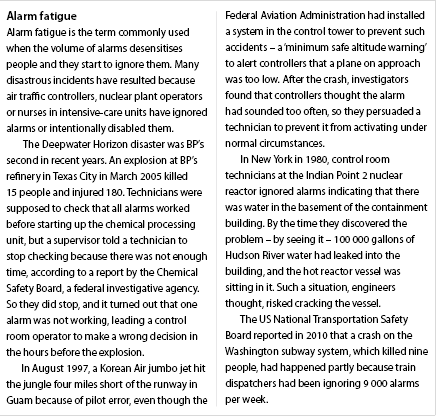
Alarm shelving is an important tool to help operators manage nuisance alarms. It is intended to temporarily hide alarms that operators feel are irrelevant or distracting, thus enabling them to maintain focus on those that require more urgent attention. The presence of nuisance alarms can desensitise operators causing them to ignore important alarms or to misdiagnose a situation. It is also a common contributor to alarm management incidents. With the release of the IEC 62682 standard ‘Management of alarm systems for the process industries’, alarm shelving has become a required control system functionality.
Yokogawa’s CAMS solution
Alarm shelving is a safe and secure way for the operator to temporarily remove a nuisance alarm from view until the underlying problem can be corrected. Much of the potential for nuisance alarms can be ‘designed out’ of the system via alarm rationalisation and application of advanced alarm design techniques. However, since processes and sensors change over time, it is inevitable that nuisance alarms will develop. Common causes include instrument malfunctions, temporary operating modes (start-up and shut-down), lack of maintenance, or operational changes (such as a different feedstock). Thus, alarm shelving is a very powerful, useful, and now required, alarm management tool. With CAMS (consolidated alarm management system), Yokogawa users have powerful and flexible alarm shelving capability built-in to their distributed control system.
Although the concept of alarm shelving has been around for some time, it has evolved over the years. The EEMUA 191 guideline contained a significant discussion about it when it was first released in 1999. Yokogawa was an early adopter of this functionality, introducing alarm shelving as part of CAMS in 2006. Shelving was codified with the release of the ISA-18.2 and IEC 62682 standards, which define alarm shelving as one of three forms of alarm suppression: the act of preventing the annunciation of the alarm to the operator when the alarm is active. The three types of alarm suppression are:
• Designed: alarm annunciation to the operator is prevented based on plant state or other conditions.
• Shelving: temporarily suppress an alarm, initiated by the operator, with engineering controls to reinstate the alarm.
• Out of service: state of an alarm during which the alarm indication is suppressed, typically manually, for reasons such as maintenance.
Shelving is characterised by its temporary nature (alarms are not suppressed indefinitely), the use of engineering controls to ensure the alarm is reinstated, and that it is initiated by, and under control of, the operator. Shelving is different from disabling or deactivating the alarm (e.g., using ‘alarm off’ or ‘detection disable’ in CAMS). The act of shelving an alarm temporarily moves it from the alarm summary display to another predefined message display area called a shelf. It stays on the shelf until the maximum suppression time is reached or the alarm has cleared (configurable in CAMS). Thus, the alarm is never ‘gone’; it will automatically come back after a period of time. Its status is maintained, tracked, and visible within the CAMS system. This is different from when an alarm is ‘disabled’, in which case it must be tracked outside of the control system and if forgotten about, may never be re-enabled.
CAMS provides powerful capabilities for implementing, using, and controlling alarm shelving. To ensure shelving is used appropriately, operators should be well trained on the purpose and procedures. For instance, a review of shelved alarms should become part of daily operations using pre-defined reports. KPIs for the number of shelved alarms, total shelving duration, and number of times an alarm has been shelved should be established in the alarm philosophy, and evaluated regularly along with other alarm system KPIs. EEMUA 191 recommends that the number of shelved alarms be less than 30.
Alarm shelving is an important tool for helping operators deal with nuisance alarms. Yokogawa was among the first DCS suppliers to provide alarm shelving with the CAMS system, which remains an industry benchmark for this type of functionality. CAMS is a powerful and flexible system that allows alarm shelving to be tailored to the requirements of plant operations.
The Alarm Shelving eBook from Yokogawa can be downloaded at http://bit.ly/YokoCAMS

For more information contact Christie Cronje, Yokogawa South Africa, +27 (0)11 831 6300, [email protected], www.yokogawa.com/za
| Tel: | +27 11 831 6300 |
| Email: | [email protected] |
| www: | www.yokogawa.com/za |
| Articles: | More information and articles about Yokogawa South Africa |

© Technews Publishing (Pty) Ltd | All Rights Reserved